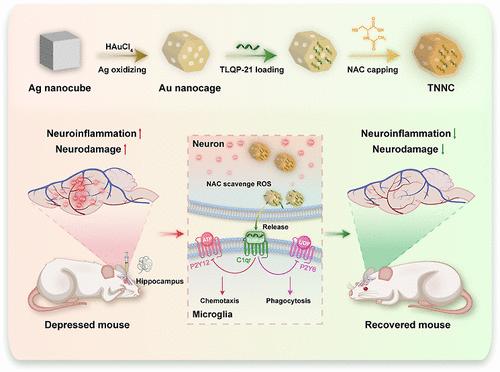N-Acetylcysteine-Capped TLQP21-Containing Au Nanocages Alleviate Depression in Mice
IF 16
1区 材料科学
Q1 CHEMISTRY, MULTIDISCIPLINARY
引用次数: 0
Abstract
Major depressive disorder (MDD) is the most prevalent neuropsychiatric disorder globally. Promising therapies for MDD are urgently needed due to the limited effectiveness, delayed efficacy, and non-negligible side effects of current treatments. Oxidative stress and neuroinflammation have been recognized as key contributors to MDD. Here, we developed an antioxidant N-acetylcysteine (NAC)-capped Au nanocage (TNNC) that entrapped VGF-derived peptide TLQP21 with neuro-immunomodulatory effects. Once internalized by cells suffering from oxidative stress, NAC was consumed, and TLQP21 was released from TNNC. TNNC administration alleviated MDD-like behaviors of the chronic unpredictable mild stress (CUMS)-exposed mice and effectively relieved oxidative stress in the brains. Moreover, TLQP21 in TNNC inhibits the activation, excessive synaptic pruning, and inflammatory responses of microglia through targeting the complement C1q receptor (C1qR) and complement C3a receptor 1 (C3aR1). This work provides a bioinspired strategy to target multiple pathogenic factors in one nanoparticle for the intervention of MDD and other diseases.

n -乙酰半胱氨酸覆盖tlqp21含金纳米笼减轻小鼠抑郁
重度抑郁症(MDD)是全球最常见的神经精神疾病。由于目前治疗方法的有效性有限、疗效延迟和不可忽视的副作用,迫切需要有前景的治疗重度抑郁症的方法。氧化应激和神经炎症被认为是MDD的关键因素。在这里,我们开发了一种抗氧化剂n -乙酰半胱氨酸(NAC)覆盖的金纳米笼(TNNC),它包裹着vgf衍生的肽TLQP21,具有神经免疫调节作用。一旦被氧化应激细胞内化,NAC被消耗,TLQP21从TNNC中释放。TNNC可减轻慢性不可预测轻度应激(CUMS)暴露小鼠的mdd样行为,有效缓解脑内氧化应激。此外,TLQP21在TNNC中通过靶向补体C1q受体(C1qR)和补体C3a受体1 (C3aR1)抑制小胶质细胞的激活、过度突触修剪和炎症反应。这项工作提供了一种生物启发的策略,在一个纳米颗粒中靶向多种致病因子,用于干预MDD和其他疾病。
本文章由计算机程序翻译,如有差异,请以英文原文为准。
求助全文
约1分钟内获得全文
求助全文
来源期刊

ACS Nano
工程技术-材料科学:综合
CiteScore
26.00
自引率
4.10%
发文量
1627
审稿时长
1.7 months
期刊介绍:
ACS Nano, published monthly, serves as an international forum for comprehensive articles on nanoscience and nanotechnology research at the intersections of chemistry, biology, materials science, physics, and engineering. The journal fosters communication among scientists in these communities, facilitating collaboration, new research opportunities, and advancements through discoveries. ACS Nano covers synthesis, assembly, characterization, theory, and simulation of nanostructures, nanobiotechnology, nanofabrication, methods and tools for nanoscience and nanotechnology, and self- and directed-assembly. Alongside original research articles, it offers thorough reviews, perspectives on cutting-edge research, and discussions envisioning the future of nanoscience and nanotechnology.
 求助内容:
求助内容: 应助结果提醒方式:
应助结果提醒方式:


